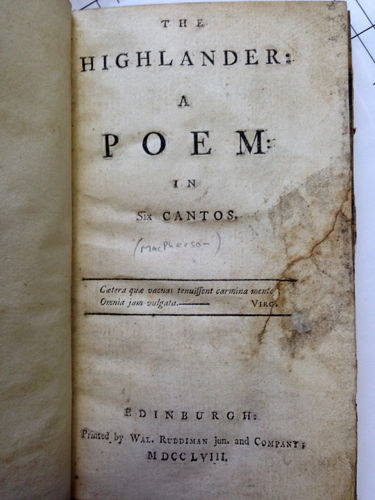
Author
James Macpherson (1736-1796)
Title
The Highlander: A Poem in Six Cantos
Published
Edinburgh: Walter Ruddiman Jr., 1758
Location
s821.4 FM3151
What is this book about?
The Highlander is an epic poem in heroic couplets. It is set in the tenth century and it depicts the Battle of Bauds near Cullen on the Moray Firth between King Indulf and Viking invaders. The poem is divided in six parts — these are called ‘cantos’ in traditional epic fashion.The poem tells the story of Alpin, a young heroic Highlander. He fight the Vikings, falls in love with Princess Culena, and is discovered to be the legitimate heir to the throne.
Perhaps the most interesting part of the poem is its prophecy in Canto V. Here, Alpin has been sent to a hermit, who predicts the future (which, for us and contemporary eighteenth-century readers is the past):
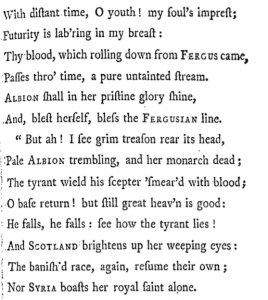
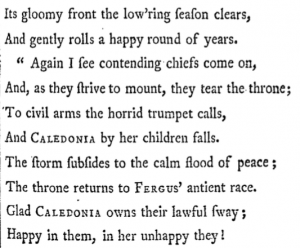
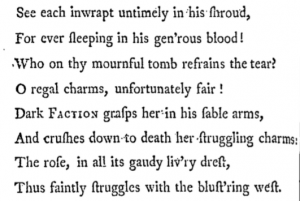
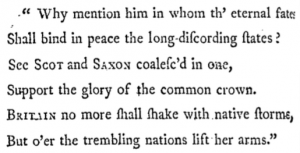
Why does this book matter?
There are only eight copies of The Highlander left: 4 in the UK, and 4 in the US. The British Library’s English Short Title Catalogue (www.estc.bl.uk) lists copies in the Aberdeen University Library, the National Library of Scotland in Edinburgh, the British Library in London, two copies at Columbia University in New York, one copy in the New York Public Library, and another at the University of Michigan – and one in Inverness Library. Furthermore, the Inverness copy contains annotations when none of the other copies do. We don’t know who annotated it; we know it wasn’t Macpherson, the author, as his handwriting looks different.
This book is also important because of its author: James Macpherson. Macpherson was one of the foremost ‘men of letters’ in eighteenth-century Britain. Born in Invertromie near Ruthven in 1736, Macpherson shot to fame with the publication of the Ossianic Collections in the 1760s. Purported to be translations of Gaelic poetry, Macpherson’s three publications – Fragments of Ancient Poetry Collected in the Highlands of Scotland (1760), Fingal (1761) and Temora (1763) sparked a debate about their authenticity that lasted for the rest of the eighteenth century. These books were hugely popular throughout the eighteenth and nineteenth century, and they kickstarted European Romanticism. The Highlander is the only published poem by Macpherson that is actually by Macpherson, and not translated, collected or edited by him.
The Highlander is also exciting because it is an adaption of Scottish History: its plot (with the exception of the love story between Duffus and Culena) is taken from chronicles and George Buchanan’s History of Scotland (1579), and the characters in it are all based on historical figures. This is particularly exciting for Macpherson, who was accused of forging the Ossianic Collections, and it shows him as a poetical historian.
